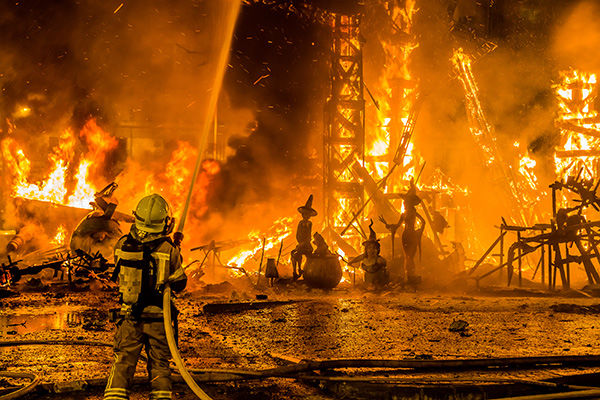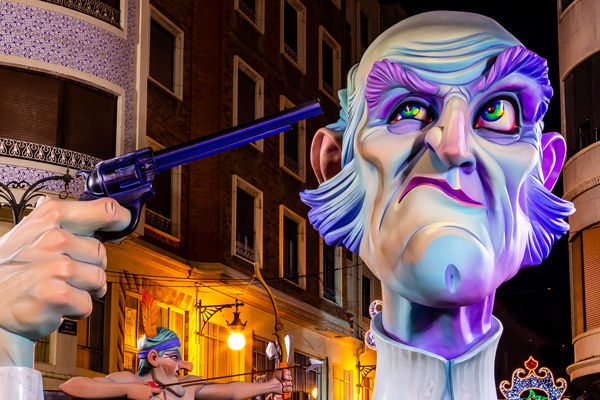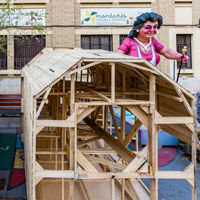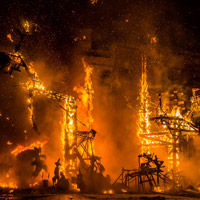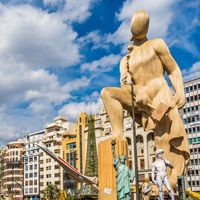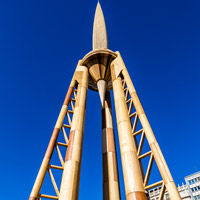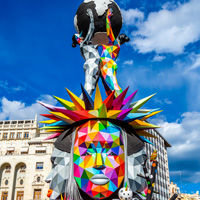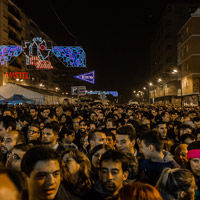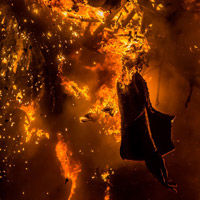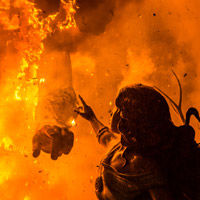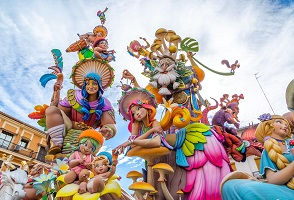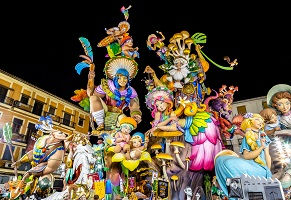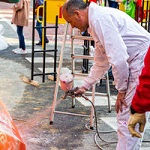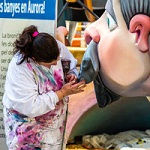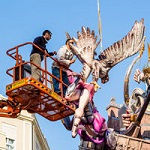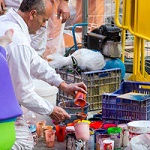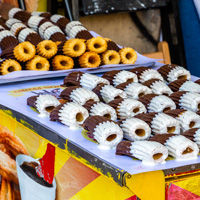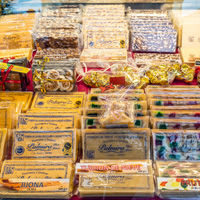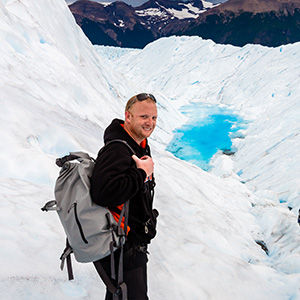A Guide to Valencia's Las Fallas Festival
Las Fallas is an incredible festival that takes place in Valencia, Spain that apparently no one knows about. I don't think I've ever mentioned this to anyone in the U.S. who knew it existed. But it’s solidly in my top 3 festivals (along with Carnevale di Venezia and the Albuquerque Int'l Balloon Fiesta). Throughout the year, hundreds of neighborhood associations plan, design, and construct large monuments. For a 4 day period (March 16-19), they are put on display throughout the city. And then on the final night every one of them is burned to the ground, and the cycle starts all over again. Add in a 24/7 party, Valencian food stalls, and lots of fireworks, and it becomes a pretty awesome four days. You can check out my photo galleries from past years below.
History of Las Fallas
Here’s the short, short version. In medieval times, carpenters and woodworkers would accumulate a lot of scraps and waste. It became a tradition in Valencia for the guilds to burn all this on St. Joseph’s Day, March 19. At some point, someone (possibly intoxicated at the time) decided to dress up the wooden boards in clothes. By the 1700s, these dressed up boards had morphed into satirical dolls and puppets that were then burned at night. Fast forward through a few hundred years of evolution and presumably competition for neighborhoods to one-up each other, and you get today’s 4-day 24/7 party with hundreds of monuments scattered throughout the city with an overall price tag of over €7,000,000 (in 2018). Valencia has the most famous festival, but given that this practice was common throughout the region there are several other cities that have fallas festivals as well (such as Alzira to the south).
In 2016, UNESCO declared Valencia’s Las Fallas festival to be an “intangible cultural heritage of humanity.”
There are hundreds of neighborhood associations throughout Valencia, and each will fund and construct their own falla. The process begins by deciding on an overall theme. Then they will compete to recruit artistas falleros, who will be responsible for the artistic design. A lot of these artistas falleros have their own distinct style, and it’s common to recognize an artist’s touch based on their aesthetic style from past years. Concept art is drafted, a scale model is built and approved, and then it’s time to build.
Each falla begins as a wooden scaffold structure. The individual parts and ninots typically start out as a plaster mold, which is then filled in with flammable material and then painted. Traditionally, the molds would be packed with pulp from wood, cardboard, and paper. Today, newer materials are used such as Styrofoam, resin, and fiberglass. These materials result in lighter components than in the past, so you can build bigger and higher. But there is controversy over these new materials due to environmental concerns when burned, as well as complaints over the black smoke that these newer materials produce that quickly obscures the view of the falla as it burns. I can personally attest to that – you only have a few seconds at the start of La Crema before you’re looking at thick black cloud of smoke. Then after a few minutes, all that’s left is the slower burning wood scaffolding.
Las Fallas Overview
Some basic terminology you'll encounter:
- Falla: The entire monument as a whole.
- Remate: The large central figure. Smaller fallas probably have one remate, but larger fallas may have several remates. These tie in to the main theme of the falla.
- Ninot: One of the smaller figures that are scattered all around the base of the falla. Often satirical in nature.
- Ninot Indultat: The ninot that wins the popular vote at the pre-festival Ninot Exhibition at the City of Arts & Science. At the end of Las Fallas, the ninot indultat gets a permanent home in the Museo Fallero instead of being burned alive. The name translates to “the pardoned ninot”.
- Falla Infantile: A smaller falla that accompanies the main falla, geared towards children and less satirical subject matter.
- Fallero/Fallera: Men and women wearing the traditional Valencian clothing.
- Artista Fallero: The artists that design the fallas.
- La Crema: The final night of the festival, where all fallas across the city are burned to the ground.

The fallas range in size from a few meters tall to a few stories tall. The Fallas commission breaks them up into essentially weight classes, with the cost being the determining factor. The fallas especiales (special section) are the largest and most expensive fallas. In 2018, there were 9 fallas in this category with a price range of €90,000 – €200,000. Sounds steep, but this seems like a bargain compared to 2009, when Falla Nou Campanar had a €1,000,000 price tag (with the three years before that coming in at €600,000, €720,000 and €800,000). Below Seccion Especial, there’s a Seccion 1A (€33,500 – €75,000), Seccion 1B (€21,100 – €33,000), etc. Sections 1 and 2 have two tiers (A & B), while section 3-8 have three tiers (A, B, & C). Section 8C is the lowest tier, where the price tag range is €600 – €2,300. In 2018, there were officially 382 fallas scattered throughout the city.
There is also always a falla in Plaza del Ayuntamiento which is generally on the same scale as the fallas especiales, but is funded by the city instead of a private crew. This is always the final falla to burn, an hour later than the other fallas (1 am instead of midnight).
Logistics
So, you’ve decided to go to Las Fallas. Congrats, it’s going to be awesome. Time to take care of the logistics – how to get there and where to stay.
Getting there is easy. Valencia Airport (VLC) isn’t a huge airport, but you should be able to grab a flight from any major hub in Europe. Status has me committed to United/Star Alliance, and from Washington D.C. I can get to VLC with one stop through Frankfurt, Munich, or Zurich. I know other airlines can get you there direct from London Gatwick, Charles de Gaulle, and Schipol. If you’re already in Spain for vacation, you can take a train direct from Madrid Atocha to Valencia in under 2 hours, or a little over 3 hours from Barcelona Sants. So you’ve got plenty of options.
When picking a hotel, you probably want to be close to the action. In my opinion, “the action” for Las Fallas lies mostly within the red area on the map below. The thin upper region is essentially the western half of the historic center, while the lower region is bounded by Carrer de Colon to the north, River Turia Park to the east, Avenida de Valero to the south, and the train tracks to the west. These two areas have the highest density of fallas, and the majority of the fallas especiales (special section). Remember that Las Fallas is one of the busiest times of the year for Valencia, and popular hotels may fill up well in advance. So book early, but only once you’re certain you’re going – a lot of hotels will require non-refundable payment in full for rooms during the festival.
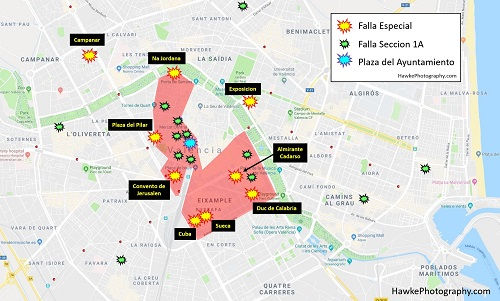
One recommendation – if you’re going to be staying close to action and actually want to get some sleep, bring a good pair of earplugs. Las Fallas is a 24/7 party with lots of drunk people and firecrackers. It’s noisy.
Getting Around Valencia
You’re going to walk. A lot. Two main reasons for this. First, if you take a look at the map above, most of the metro stops appear as small red dots. Notice that very few of them appear within the red region, and even then only around the edges. You can take public transport to the outskirts, but you’ll be walking from there. Second, even if you could metro falla-to-falla, you’d be missing out on half the fun. There are hundreds of fallas scattered around the city, and it’s very easy to get distracted and make a detour to see something you spotted a couple blocks away down a side street, followed by another detour, and then the detours just keep on compounding. Walking from Plaza del Ayuntamiento to the Na Jordana Falla (northernmost tip of the red region) would normally be a 1 mile, 20 minute walk. But during Las Fallas, you might find yourself snaking your way all over the historic center and end up arriving several hours later.
You’ll likely use the metro a bit as well. The metro system is called Metrovalencia (English Website). It consists of 9 lines, but a lot of those merge on to the same tracks in the center of the city, so really you only need to worry about two or three different lines. If you arrive via the airport, lines 3 and 5 both provide a direct shot in to the city center in 20 minutes – the Xativa station is located at the main train station (which means plenty of taxis as well) and is just two blocks from Plaza del Ayuntamiento. For normal trips in the city center, the cost for a single one-way ticket is €1.50 (airport trip is more expensive). Or you can get a 10-trip bonometro card for €7.60, which is a far better deal. You also have the option of a Valencia tourist card that gives you unlimited public transport trips in addition to discounts at all the normal tourist sights (€13.50 for 1 day, €18 for 2 days, €22.50 for 3 days).
I can usually get by with a single 10-trip bonometro. Like I mentioned, you’ll be walking the vast majority of the time. However, one of the fallas especiales (Falla L’Antiga de Campanar) is outside the city center but just a block from the Campanar metro station (lines 1 & 2). The second of the 2 fallas especiales outside the red region above is an easy walk from the Alameda station (lines 3, 5, 7, & 9). Other than that, you really won’t be using the metro a whole lot unless you go out beyond the red region. If you wanted to see all the Seccion 1A fallas, you’re going to need at least a full 10-trip bonometro to get to those outer five.
One thing to keep in mind, there are two official languages in Valencia – Spanish and Valencian. Depending on your map, your map street names may not match the street signs. It’s not terribly difficult to figure out, but don’t blindly expect an exact match. For example, Plaza del Ayuntamiento is Placa de l’Ajuntament, and Avenida del Oeste is Avinguda de l’Oest.
Strategery
I approach Las Fallas a bit like I approach Disney World. Can you just show up, wander around seeing things spur of the moment, and have a good time? Sure. But you’re going to have a far better time if you actually come up with a game plan ahead of time.
That said, you could have a pretty awesome time even without a plan. If all you did was Bird Box challenge your way around Valencia and only took the blindfold off at the 9 fallas especiales, you would be very impressed. Or if you never left the red region on the map, you’d still see the vast majority of the largest fallas. In fact, that’s exactly what I’d recommend if you only had 1 or 2 days to spend in Valencia during Las Fallas – spend all your time in the red region.

But if you’re there for the entire four days of the festival, then you have a bit more time to explore. There are two tools that will help you focus that exploration. One is the magazine El Turista Fallero. This is a full size 150+ page magazine that will have the concept art for every falla in Valencia, from the fallas especiales all the way down to Seccion 8C, plus a map with the location of most of them noted. See an example on the right - I would have never come across that Star Wars falla by random chance. There is typically a table at each of the fallas especiales selling El Turista Fallero, as well as a smaller pamphlet that just has pictures and a map of the fallas especiales and Seccion 1A fallas. The second tool is an app, which essentially does the same thing (concept art for each falla), but it has a more interactive map and might be a better option for people with cell data coverage. (Note: as of this post, a 2019 app has not been released. But apps were released for 2017 and 2018, so hopefully it’s just a matter of time). This is how I’ll spend my breakfasts at the hotel, going through all the concept art to see if there are any specific fallas I want to track down that day.
You also have plenty of non-fallas activities to keep you occupied. Every day at 2pm there is a huge mascleta at the Plaza del Ayuntamiento (a mascleta is just thousands of firecrackers going off rapid-fire for several minutes). On March 17 & 18 there are huge processions of falleros and falleras through the streets of the historic center to make flower offerings at the Plaza de la Virgen. And lots of food stalls scattered throughout the city, with notable concentrations at the Valencia Nord train station, Mercat Central area, and the Ruzafa area near the fallas especiales Cuba and Sueca.
Here’s my typical gameplan. March 16 (day 1), first thing at 8am (which is when all fallas are supposed to be officially complete) I’ll metro out to Falla L’Antiga de Campanar. That falla is oriented with the primary side facing east, so if you see it in the morning the most important part won’t be backlit. Then walk from there to Falla Na Jordana. That’s a 1.25 mile walk but it’s quick since there’s really nothing of note along that route (unless you find public bus stations fascinating). Then I spend the rest of the day winding my way south through the historic city center, ending back by the train station (and my hotel). So by end of day 1, I’ve seen 3 fallas especiales. March 16 is the least crowded day in the historic center, because on March 17 & 18 you have falleras marching through the streets for the floral offering processions, which can block off major roads and limit your mobility (just a few allowed road crossings which causes bottlenecks). So I think it’s far better to explore the city center on March 16.
March 17, hit Falla Convento de Jerusalén first thing in the morning. Then loop back and around the train station to start on the western edge of the red region, and snake my way east. Once I’ve hit the eastern edge, hop across River Turia Park and see Falla Exposición. By the end of day 2, I’ve seen the other six fallas especiales.
March 18 & 19 (days 3 & 4) are fluid. In theory, if the weather has cooperated (although to date I think I’m 1 for 3 with entirely rain-free festivals), I’ve seen all nine fallas especiales at this point. So these two days are based on what concept art in the El Turista Fallero magazine has piqued my interest. Default mode may be to head out to the Seccion 1A fallas in the suburbs, but if there are smaller fallas that I specifically want to see (such as anything with a Star Wars theme) then I’ll make my way to those. Or if the list of minor fallas I specifically want to see is manageable, I can go hang out in the historic center and watch the floral offering processions. Or I can just wander around eating churros and drinking caipirinhas all day.
A couple things to keep in mind on March 19, the final day:
- There is a Cavalcada del Foc (Fire Parade) that starts at 7pm near the bullfighting ring and goes down Carrer de Colon to end at Puerta del Mar. It’s not terribly exciting but if you’re already in the area, it doesn’t take up too much time.
- They start to break things down early to prepare for La Crema. So don’t expect to roll up to the fallas especiales at 9pm and pay entry to get a close-up look – they will have already closed that off to the public and will have started the process of drilling holes and planting fireworks to burn it down. I shoot to see all the fallas especiales I want to see (which is all of them) by the end of March 18.
- La Crema occurs on the final night with the fallas infantiles igniting at 10pm and the main fallas igniting at midnight (with the 1st prize falla especial igniting at 12:30am and the Plaza del Ayuntamiento falla at 1 am). They’re not exactly prompt, so those times could be delayed. And if you want a good view of one of the fallas especiales burning down, I’d recommend getting there at minimum an hour early (basically watch a nearby falla infantile burn, then immediately go stake out a spot).
A note on fireworks… There are fireworks displays the first three nights of the festival near Paseo de la Alameda, as well as pre-festival fireworks on March 15 at Plaza del Ayuntamiento. Generally March 15 & 16 fireworks happen at midnight, March 17 at 1 am, and March 18 at 1:30 am which is the Nit del Foc (translates to Night of Fire) and is supposed to be the largest of the 4 shows. So if you like fireworks, head down to the River Turia Park in the stretch on either side of the Alameda metro station. Personally, I’ve seen plenty of fireworks in my life. So I use the time for night photography of the fallas instead. The crowds noticeably thin out when it’s time for fireworks. I’d much rather use that time checking out sculptures that are going to be nothing but ash in a few days, never to exist again.
Viewing the Fallas
Seems pretty self-explanatory – just look at them, right? But there are a couple points to keep in mind.
- I personally feel the fallas look better at night (just like Las Vegas). The lighting is more even, colors seem more vibrant against the night sky, and there’s no sun causing harsh backlit conditions. I will typically end up seeing most of the fallas especiales twice, once during the day and then again at night.
- All the fallas are 360 degree sculptures. There are ninots on display both front and back, so take the time to walk around them.
- The 9 fallas especiales will all be fenced off, with an open space around the base. There is generally a crush of humanity around the outside of the fence. However, with a small entry fee (typically €1 – €3), you can go inside the fence. This gives you a more close-up view, better photography options, and a much more calm experience. I honestly have no clue why more people don’t pay to go inside, but it’s usually pretty sparse in terms of people. I recommend it.
- If you see a particular falla that you want to see burn, make sure to write down the intersection. Some Valencia neighborhoods aren’t exactly grid-like, and you might have trouble tracking down a falla you saw two days ago by just wandering around.
- All the fallas are satirical in nature, with most of it directed towards Spanish and local politics (although European and world politics get their fair share as well). So there are plenty of cases where locals are clearly amused at something, while I have no idea what’s going on. Just recognize that if you’re a tourist, a lot of the satire is going to go way over your head. Seeing as I don’t have the time to brush up on local Valencian politics, I just accept it.
- The fallas don’t instantly go up overnight. If you get to Valencia a day or two early, you can wander around and see the crews unpacking and assembling them, touch-up painting, etc. It’s actually pretty interesting.
The Food of Las Fallas
Think you’re going to lose weight during Las Fallas due to all the walking? Nope. You are mistaken. Street food stalls are all over the place, and it all looks good. The food of Las Fallas merits an entire blog post on its own, but here’s a quick rundown of what you’ll encounter.
- Buñuelo de Calabaza: Deep fried pumpkin fritters, either fried balls of dough or donut shaped. Probably considered the signature food item of Las Fallas. (You can also get non-pumpkin buñuelos.)
- Churro: Churro food stalls (churrerias) will be all over the place, cranking out fresh churros 24/7. Get them sprinkled in sugar, or dip them in melted chocolate.
- Churro Relleno: If you think churros are too healthy, try a churro relleno. It’s a churro that’s injected with custard, chocolate, or dulce de leche (similar to caramel). Quality seems to vary greatly by food stall, so look for busy stalls that make are making them fresh and try to remember the location if you find a winner.
- Beer: You’ll see the names Mahou and Amstel plastered all over the place. Both are breweries, Mahou is local to Spain while Amstel is owned by Heineken. It seems like Mahou is one of the largest sponsors of Las Fallas – you’ll see the name on fence barriers and sponsoring many of the fallas crews. Pretty much every shop in Valencia will be selling cold cans for €1. I don’t know what the open-container laws are like in Valencia the rest of the year, but they are non-existent during Las Fallas.
- Booze: Mixed in with all the food stalls will be mixed drink stalls. Caipirinhas and mojitos seem to be the two most popular drinks served, along with all your standard mixed drinks.
- Horchata: A non-alcoholic milk-like drink made from tiger nuts. Think almond milk, only sweeter. You’ll see this sold from one-person carts.
- Paella: Well, this is typically more of a sit-down restaurant type deal than a street food. But if you want to try paella in Spain, Valencia is the place to do it. Just research a good place – there are plenty of microwaved meal tourist traps in addition to the legit places.
- Turron: Bricks of nougat made of egg whites/sugar/honey/almonds. There are two main types – Alicante is hard and uses whole almonds, while jijona is much softer because the almonds are turned in to a paste.

Other Things to Do in Valencia
I get it, four days of staring at fallas might start to get stale after a while. Fortunately, there are plenty of other things going on to keep you occupied.
- Ninot Exhibition: An exhibition at the City of Arts & Science complex, where each of the fallas loans out one ninot to be put on display. The day before the festival starts, it shuts down and all the ninots get returned back to the crews (so this is only an option if you arrive in Valencia early). There is a vote each year, and the winner gets to avoid being burned alive, and instead gets a permanent home in the Museo Fallero.
- Mascletas: Non-stop firecrackers and gunpowder for several minutes. The main event occurs at 2pm every day at Plaza del Ayuntamiento, plus plenty of fallas crews will set up their own smaller mascletas.
- Floral Offering Processions (Ofrenda de las Flores): March 17 & 18, head to the historical city center and they are impossible to miss. Processions of groups of falleras all carrying bouquets of carnations to the Plaza de la Virgen. You’ll hear them before you see them, since each group of falleras is trailed by a brass band.
- Fireworks: Every night for the first three nights of the festival, with Nit del Foc on the night of the 18th.
- Valencia C.F. Football Match: On occasion Valencia C.F. will host a match during the festival. They play at Mestalla Stadium, which is just a few minutes walk from Alameda station, on the other side of River Turia Park from the city center.
- Bullfighting: It’s extremely controversial, but the Plaza del Toros right next to the train station runs bullfights every afternoon during Las Fallas if you are so inclined.
- Museo Fallero: Across the street from the City of Arts & Sciences, this is a museum about Las Fallas and features a ninot from each year that won the popular vote to be saved.
- The Beach: Personal opinion, the beach will always be there while the clock is ticking for the fallas. But yeah, Playa Malvarrosa can be accessed off metro line 6.
- General tourist things (City of Arts and Science, Valencia Cathedral, Mercat Central, etc.)

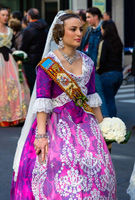
So there you go, a brain-dump of everything you need to know to enjoy Las Fallas. If you’ve got any questions, you are welcome to contact me here on this site, or through Instagram (@hawkephotography). It really is an amazing experience.
I will give a shout out to Cendra Digital - www.cendradigital.com. If you’re interested in Las Fallas, these guys have all the news in the months leading up to the event, photos of all the concept art as it gets released, and a pretty comprehensive database of past years with photos and artist information.
And... one final pitch below for my photo galleries over the past three years:
